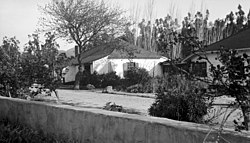Rancho Camulos | |
California Historical Landmark No. 553 | |
 A view of Rancho Camulos from the northwest. | |
| Location | 5164 East Telegraph Road, Piru, California |
|---|---|
| Coordinates | 34°24′24″N 118°45′24″W / 34.40667°N 118.75667°W |
| Built | 1853 |
| Architectural style | Spanish Colonial Mission Revival Spanish Colonial Revival |
| NRHP reference No. | 96001137 |
| CHISL No. | 553 |
| Significant dates | |
| Added to NRHP | November 1, 1996[2] |
| Designated NHL | February 16, 2000[3] |
| Designated CHISL | 1956[1] |
Rancho Camulos, now known as Rancho Camulos Museum, is a ranch located in the Santa Clara River Valley 2.2 miles (3.5 km) east of Piru, California and just north of the Santa Clara River, in Ventura County, California.[4] It was the home of Ygnacio del Valle, a Californio alcalde of the Pueblo de Los Angeles in the 19th century and later elected member of the California State Assembly. The ranch was known as the Home of Ramona because it was widely believed to have been the setting of the popular 1884 novel Ramona by Helen Hunt Jackson. The novel helped to raise awareness about the Californio lifestyle and romanticized "the mission and rancho era of California history."[3]
The 1,800-acre (7 km2) working ranch is a prime example of an early California rancho in its original rural setting. It was the source of the first commercially grown oranges in Ventura County.[5] It is one of the few remaining citrus growers in Southern California.
State Route 126 bisects the property, with most of the main buildings located south of the highway, and a few buildings on the north. The main adobe is one of the few extant Spanish Colonial buildings left in the state. Most of the other buildings are done in Mission Revival or Spanish Colonial Revival styles, both of which are derivatives of the original.
Rancho Camulos is designated a National Historic Landmark, listed on the National Register of Historic Places, and has also been designated as a California Historical Landmark. Many of the buildings and grounds are open to the public as a museum of this period in California history.
- ^ "Rancho Camulos". Office of Historic Preservation, California State Parks. Retrieved October 12, 2015.
- ^ "National Register Information System". National Register of Historic Places. National Park Service. March 15, 2006.
- ^ a b "Rancho Camulos". National Historic Landmark summary listing. National Park Service. Archived from the original on January 17, 2008. Retrieved January 27, 2008.
- ^ "Camulos". Geographic Names Information System. United States Geological Survey, United States Department of the Interior. Retrieved December 15, 2014.
- ^ Cite error: The named reference
historywas invoked but never defined (see the help page).

